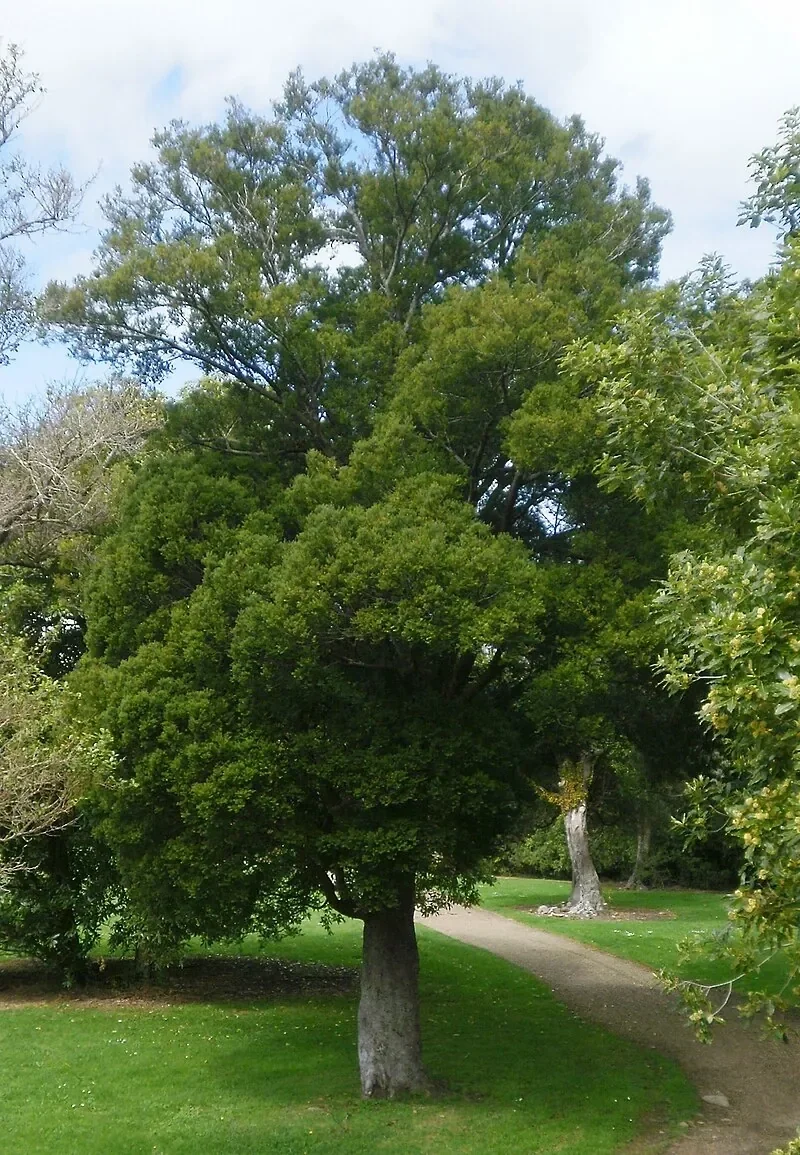
Miro
Prumnopitys ferruginea
Introduction
Introduction Overview
Miro ( Prumnopitys ) is a large native New Zealand conifer with dark green foliage and bright red fruit. It is important for native birds and valued for its timber and ecological role. native trees .

Plant Description
Botanical Features
Miro ( Prumnopitys ferruginea ) is a tall, slow-growing evergreen conifer native to New Zealand, found throughout the North, South, and Stewart Islands. It can reach heights of up to 25 meters, with some specimens growing to 30 meters, and has a trunk diameter of 1 to 1.5 meters. The tree typically has a round or domed crown and its trunk is often clear of branches for two-thirds of its length in mature adults. Its distinctive foliage consists of dark green, feathery, slightly curved, and pointed linear leaves, often flattened into two rows, especially in juvenile stages. These leaves are described as "pectinate," meaning they are arranged closely together like a comb. The bark is thick, grey, and sheds in sinuous flakes. Miro is a dioecious species, meaning individual trees are either male or female. It produces small, fleshy cones. The female trees bear attractive, broadly oblong to sub-spherical red or pink-red fleshy drupes (fruit) up to 20 mm long, which ripen from late spring to early autumn. These fruits have a resinous flavor and are an important food source for native birds, particularly the New Zealand wood-pigeon (kererū), which aids in seed dispersal.
Quick Facts
Quick Facts Overview
| Scientific Name | Prumnopitys Ferruginea |
|---|---|
| Height | Up to 25 m (82 ft) |
| Spread | 4-8 m |
| Water Needs | Moderate to high (prefers moist, well-drained soil) |
| Light | Partial shade to full sun |
| Frost Tolerance | Moderate (tolerates light to moderate frost) |
| Salt Tolerance | Low |
| Growth Rate | Slow to moderate |
| Lifespan | Centuries |
Climate Best Suited to
Prumnopitys is native to New Zealand and thrives in the country's diverse climate conditions. It adapts well to various regional climates throughout the country.
Regional Suitability
| City | Climate Suitability |
|---|---|
| Whangārei | Ideal |
| Auckland | Ideal |
| Hamilton | Ideal |
| Tauranga | Ideal |
| Rotorua | Ideal |
| Gisborne | Ideal |
| New Plymouth | Ideal |
| Napier | Ideal |
| Whanganui | Ideal |
| Palmerston North | Ideal |
| Wellington | Ideal |
| Nelson | Ideal |
| Christchurch | Ideal |
| Dunedin | Ideal |
| Invercargill | Ideal |
Natural Habitat
Natural Habitat Overview
Prumnopitys is naturally found in specific habitats throughout New Zealand. Understanding its natural environment helps in providing appropriate growing conditions in cultivation.
Plant Conservation
Conservation
Prumnopitys ferruginea , commonly known as Miro, is a New Zealand native conifer that is currently classified as "Least Concern" by the IUCN Red List (2013) and is generally considered "Not Threatened" in New Zealand. Despite its overall stable status, the species faces conservation challenges. Historically, extensive logging and forest clearing for agriculture significantly reduced miro-dominated forests. Browsing by animals can also affect the plant. Climate change, leading to an upward shift in its elevational limits, is another concern. Miro plays a vital ecological role in New Zealand's forests. It is a long-lived tree that provides crucial habitat for native birds and insects, stabilizes soil, prevents erosion, and acts as a carbon sink. Its fruits are a significant food source for numerous native birds, particularly the kererū ōī (New Zealand pigeon), which are essential for seed dispersal. Conservation efforts include protecting and restoring its natural habitat, controlling pests and diseases, supporting reforestation initiatives, and further research on establishment methods. It is worth noting that in 2019, the species was reclassified into a new genus, Pectinopitys , and is now scientifically known as Pectinopitys ferruginea .
Soil Requirements
Prefers moist , well-draining soil rich in organic matter.
- Rich in organic matter
- Well-draining
Light Requirements
Partial shade to dappled sunlight.
- Partial shade
- Dappled sunlight
Water Requirements
Consistent moisture , avoid waterlogging.
- Consistent moisture
- Do not allow to dry out
Planting Guide
When to Plant
Best planted in spring or autumn when soil is moist and temperatures are mild.
Site Selection
- Choose a partly shaded, well-drained site
Planting Procedure
- Prepare soil by removing weeds
- Dig a hole just large enough for the root ball
- Plant at the same depth as in the pot
- Backfill and firm gently
- Water in well
Ecological Role
Wildlife Interactions
This plant plays an important ecological role in New Zealand's native ecosystems. It provides habitat and food for native wildlife and contributes to ecosystem health and biodiversity.
Uses and Applications
Practical Applications
Prumnopitys has various practical and ornamental uses. From traditional Māori applications to modern landscaping, this versatile plant serves multiple purposes.
Historically, Prumnopitys was used by Māori for medicinal purposes, food, and cultural practices. These traditional uses reflect the deep knowledge of native plants.
Landscaping Uses
Landscaping Uses Overview
Prumnopitys is highly valued in landscaping for its aesthetic appeal and practical benefits. It can be used in various garden styles and landscape applications.
Seasonal Care Calendar
Spring
- Monitor for new growth and ensure adequate moisture
- Apply slow -release native plant fertilizer if needed
- Check for any winter damage and prune if necessary
- Watch for emerging male and female cones
Summer
- Maintain consistent soil moisture, especially during dry spells
- Provide shade for young plants in hot conditions
- Monitor for scale insects or aphids
- Observe developing female cones and berries
Autumn
- Collect ripe red berries for seed propagation
- Reduce watering as temperatures cool
- Apply mulch to protect roots from winter cold
- Prune any dead or damaged branches
Winter
- Protect young plants from heavy frost
- Ensure good drainage to prevent root rot
- Minimal watering required during dormancy
- Plan spring planting or propagation activities
Each season brings different care requirements for Prumnopitys. Understanding these seasonal needs helps ensure the plant thrives throughout the year and maintains its health and appearance.
Adapting care practices to seasonal changes also helps the plant develop natural resilience and reduces the need for intensive maintenance. This approach supports sustainable gardening practices.
Pruning and Maintenance
Pruning and Maintenance Overview
Prumnopitys generally requires minimal pruning. Remove dead or damaged growth as needed and shape the plant to maintain desired form. Pruning is best done in late winter or early spring before new growth begins.
How to Grow Miro
Miro ( Prumnopitys ferruginea ) is a long-lived podocarp native to New Zealand forests, highly valued for its timber, ecological role, and distinctive red fruit. This majestic conifer is a significant component of lowland and montane forests, providing crucial habitat and food for native birds. Its dense, dark green foliage and robust growth make it a striking specimen in larger gardens and restoration projects. While it is a slow-growing species, its longevity and resilience make it a rewarding plant to cultivate. Understanding its propagation methods is key to successfully establishing this important native tree.
From Seed
Propagating Miro from fresh seed is the most reliable method. Collect ripe, dark red 'fruits' (fleshy arils) when they are fully coloured and birds begin to feed on them, typically in late autumn or early winter. It is crucial to remove all fleshy pulp from the seeds, as this can inhibit germination; soaking and gently rubbing can help with this process. Wash the seeds thoroughly and sow them promptly, as fresh, clean seed gives the best viability. Use a free-draining, sterile seed-raising mix, such as a blend of sand and fine bark. Sow the seeds at a depth approximately equal to the seed's diameter and keep the medium evenly moist in bright, indirect light. Cool to mild temperatures (around 10-18 °C) suit germination, which can be slow and irregular, often taking several months. Consider a cool, moist period (stratification) to break dormancy if germination lags. Once seedlings have developed a few true leaves and their root systems are secure, carefully prick them out into individual small pots, disturbing the roots as little as possible. Grow them on in light shade with steady moisture before gradually hardening them off.
From Juvenile Cuttings
Vegetative propagation of Miro from cuttings can be challenging, with success rates often variable. Juvenile cuttings (6-10 cm) taken from non-flowering shoots in late summer to early autumn may root under high humidity and gentle bottom heat (around 18-22 °C) with IBA (Indole-3-butyric acid) rooting hormone in a very free-draining medium (e.g., coarse perlite with fine bark). Success is variable and rooting is slow; this method is primarily used to maintain selected forms or for specialized nursery propagation. Pot on only once a firm root system has formed, and then gradually wean the new plants from high humidity. This method is generally more successful for experienced propagators or in in-vitro propagation settings.
Pests and Diseases
Common Pests
Prumnopitys is generally resistant to most pests due to its native adaptations. However, it may occasionally be affected by common garden pests such as aphids or scale insects.
Disease Prevention
To prevent diseases, ensure good air circulation around Prumnopitys and avoid overwatering. Remove any diseased plant material promptly to prevent spread.
Cultural Significance
Cultural Importance
Miro and Birds
Miro's fleshy drupes are a key seasonal food for kererū ōī, shaping seed dispersal in podocarp forests. The dense, fine-grained timber has been valued for carpentry and craft.
Prumnopitys ferruginea , commonly known as Miro, holds significant cultural importance, particularly for the Māori people of New Zealand. The Miro tree was highly valued by Māori due to its fruit, which was a favorite food of the kererū ōī (New Zealand pigeon). Māori hunters would strategically place water troughs near Miro trees, as the berries made the birds thirsty, allowing for easier snaring of the kererū ōī. Trees abundant with fruit were often given proper names, and only specific individuals had the right to snare birds from them, highlighting their value as tribal landmarks and assets. Māori also ate the fruit, despite its turpentine-like smell and taste. The Miro tree was a significant source of traditional medicine. An oil extracted from the drupes was used as an insect repellent and to aid recovery from fever. The gum exuding from the bark was applied to wounds and ulcers. A liquor prepared from the leaves and bark was taken internally for gonorrhoea, and a bark infusion was used for stomach aches. Miro oil, infused with fragrant herbs, was also used for cosmetic purposes. The Miro tree is associated with the god Tāne, who is regarded as the god of the forest. While not extensively used for timber by Māori, the wood was sometimes used for carving and building. Early European bushmen also recognized the antiseptic properties of Miro, using the gum for treating wounds. Miro timber was historically used for construction, including houses, beams, furniture, flooring, and weatherboards, often as a substitute for mataÄ«.
Bonus Tip
Expert Growing Advice
Miro ( Prumnopitys ferruginea ) has a unique reproductive strategy. Unlike most conifers that have wind-dispersed winged seeds, Miro produces fleshy, bright red, plum-like berries (modified cones) that attract birds for seed dispersal. Interestingly, these fruits, despite smelling strongly of turpentine, are a favorite of native birds like the kererū (New Zealand pigeon), kākā, kākā, and tūī, which play a crucial role in dispersing its seeds.







